Chapter 5 - Transpiration Exercise 60
Question 1
Answer the following (only in few words);
(i) What is transpiration?
(ii) In which form, water comes out in transpiration?
(iii) Where does transpiration take place in leaves? Give names of the various parts.
(iv) Give one important difference between transpiration and evaporation.
(v) When does stomatal transpiration take place in plants?
(vi) From which structure cuticular transpiration occur in plants?
(vii) How does transpiration take place in night?
(viii) What is the effect of temperature on transpiration?
(ix) What is the impact of more atmospheric pressure on transpiration?
(x) What is the relationship between transpiration water and water absorbed from the soil?
(i) What is transpiration?
(ii) In which form, water comes out in transpiration?
(iii) Where does transpiration take place in leaves? Give names of the various parts.
(iv) Give one important difference between transpiration and evaporation.
(v) When does stomatal transpiration take place in plants?
(vi) From which structure cuticular transpiration occur in plants?
(vii) How does transpiration take place in night?
(viii) What is the effect of temperature on transpiration?
(ix) What is the impact of more atmospheric pressure on transpiration?
(x) What is the relationship between transpiration water and water absorbed from the soil?
Solution 1
(i) Transpiration: It is the loss of water in the form of water vapour from aerial parts of the plant.
(ii) During transpiration, water comes out in the form of water vapour.
(iii) Transpiration takes place in leaves through stomata. Stomata consist of guard cells, epidermal cells, chloroplast and nucleus.
(iv) The important difference between transpiration and evaporation is that transpiration is the loss of water from the aerial parts of the plant while evaporation is loss of water from any surface.
(v) Stomatal transpiration occurs mainly during the day time when the guard cells of stoma are fully turgid and the stomata are fully open.
(vi) Cuticular transpiration occurs through the cuticle which is present on the epidermis of leaves & herbaceous stem.
(vii) Rate of transpiration slows down at night because photosynthesis does not take place and the stomata remains closed.
(viii) There is a direct effect of temperature on transpiration as the increase in temperature results in increase in the rate of transpiration.
(ix) When the atmospheric pressure is higher, less water vapour is lost and the rate of transpiration lowers.
(x) The relationship between transpiration water and water absorbed from the soil is that if the soil is deficient in water then the rate of water absorption decreases which hence decreases the rate of transpiration and if the soil has excessive water then the rate of water absorption increases which in turn increases the rate of transpiration.
(ii) During transpiration, water comes out in the form of water vapour.
(iii) Transpiration takes place in leaves through stomata. Stomata consist of guard cells, epidermal cells, chloroplast and nucleus.
(iv) The important difference between transpiration and evaporation is that transpiration is the loss of water from the aerial parts of the plant while evaporation is loss of water from any surface.
(v) Stomatal transpiration occurs mainly during the day time when the guard cells of stoma are fully turgid and the stomata are fully open.
(vi) Cuticular transpiration occurs through the cuticle which is present on the epidermis of leaves & herbaceous stem.
(vii) Rate of transpiration slows down at night because photosynthesis does not take place and the stomata remains closed.
(viii) There is a direct effect of temperature on transpiration as the increase in temperature results in increase in the rate of transpiration.
(ix) When the atmospheric pressure is higher, less water vapour is lost and the rate of transpiration lowers.
(x) The relationship between transpiration water and water absorbed from the soil is that if the soil is deficient in water then the rate of water absorption decreases which hence decreases the rate of transpiration and if the soil has excessive water then the rate of water absorption increases which in turn increases the rate of transpiration.
Question 2
Suggest with an experiment, evaporation of water in vapour form, in transpiration process.
Solution 2
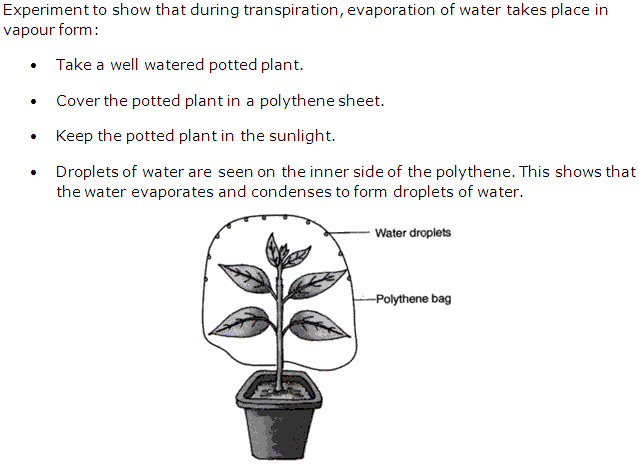
Question 3
How many types of transpiration are found in plants?
Solution 3
There are three types of transpiration found in plants:
(a) Cuticular transpiration (b) Lenticular transpiration (c) Stomatal transpiration
(a) Cuticular transpiration (b) Lenticular transpiration (c) Stomatal transpiration
Question 4
When does transpiration occur the highest?
Solution 4
The transpiration occurs highest during the day time as with the increase in light intensity the rate of transpiration increases.
Question 5
What is the difference between transpiration and evaporation?
Solution 5

Question 6
What is the difference between transpiration and guttation?
Solution 6

Question 7
Give three means of water loss in plants.
Solution 7
The three means of water loss in plants are:
(a) Respiration (b) Guttation (c) Bleeding
(a) Respiration (b) Guttation (c) Bleeding
Chapter 5 - Transpiration Exercise 61
Question 1
Why is transpiration important for plants?
Solution 1
Transpiration is important for plants because it evaporates excess water which produces a cooling effect to plants. This process also helps in ascent of sap and transportation of water and minerals to the various parts of the plants.
Question 2
What do you mean by transpiration? Explain its importance in plants.
Solution 2
Transpiration: It is the loss of water in the form of water vapour usually during day time.
Following are its importance in plants:
1. It causes transpirational pull which helps in the absorption of water.
2. It produces a cooling effect.
3. It helps in the ascent of sap.
Following are its importance in plants:
1. It causes transpirational pull which helps in the absorption of water.
2. It produces a cooling effect.
3. It helps in the ascent of sap.
Question 3
Explain typical structure of stomata.
Solution 3
The typical structure of stomata:
Stomata are minute pores of elliptical shape surrounded by two specialized epidermal cells called guard cells.These guard cells are kidney shaped which control the opening and closing of stomata.It also consists of nucleus, stoma, epidermis and chloroplast.
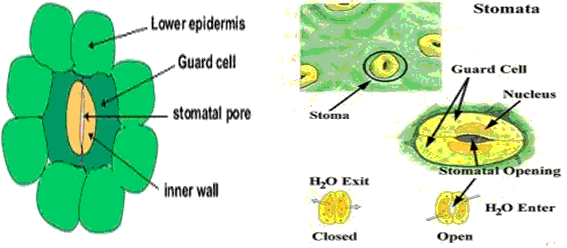
Stomata are minute pores of elliptical shape surrounded by two specialized epidermal cells called guard cells.These guard cells are kidney shaped which control the opening and closing of stomata.It also consists of nucleus, stoma, epidermis and chloroplast.

Question 4
Explain the importance of transpiration.
Solution 4
Following are the importance of transpiration :
1. It causes transpirational pull which helps in the absorption of water.
2. It produces a cooling effect.
3. It helps in the ascent of sap.
1. It causes transpirational pull which helps in the absorption of water.
2. It produces a cooling effect.
3. It helps in the ascent of sap.
Question 5
Write short notes on the following:
(i) Hydathodes
(ii) Guttation
(i) Hydathodes
(ii) Guttation
Solution 5
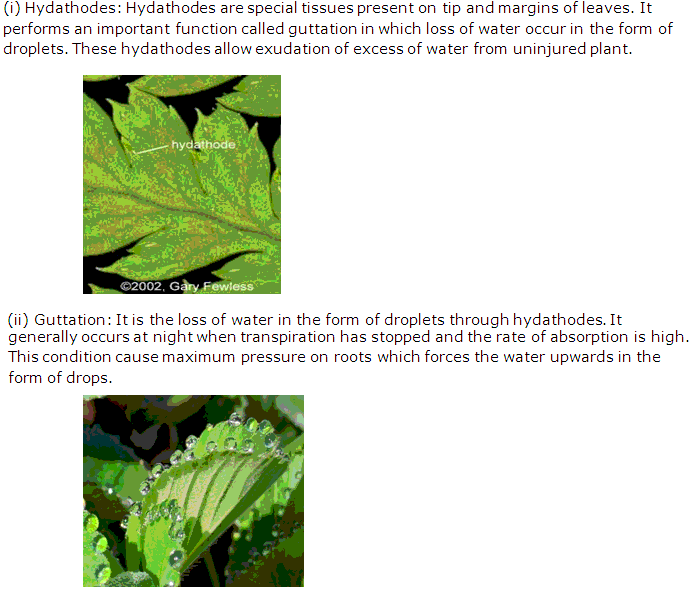
Question 6
Explain how the rate of transpiration is affected on:
(i) a windy day (ii) a foggy day?
(i) a windy day (ii) a foggy day?
Solution 6
(i) A windy day: On a windy day the water vapour released from the leaves by transpiration is removed faster and the leaf does not get saturated with water. So, transpiration is more during a windy day.
(ii) A foggy day: On a foggy day the area outside the leaf is saturated with water. So, water vapour from the leaves is removed very slowly thereby reducing transpiration.
(ii) A foggy day: On a foggy day the area outside the leaf is saturated with water. So, water vapour from the leaves is removed very slowly thereby reducing transpiration.
Question 7
What is the impact of transpiration on absorption? Explain.
Solution 7
Transpiration increases the rate of water absorption because it causes the concentration of sap to rise. In this condition cells absorb water from their neighbours, leaf, stem and root which creates transpirational pull which finally helps in the absorption of water.
Question 8
The diagram given alongside is an apparatus used to study a particular phenomenon in plants.
(i) Name the apparatus.
(ii) What is it used for?
(iii) What is the role played by the air bubble in this experiment?
(iv) Of what use is the reservoir?
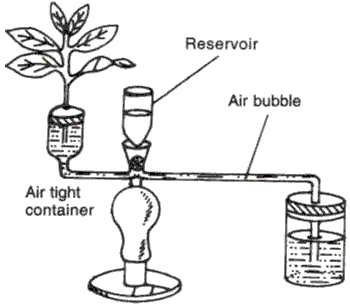
(i) Name the apparatus.
(ii) What is it used for?
(iii) What is the role played by the air bubble in this experiment?
(iv) Of what use is the reservoir?

Solution 8
(i) Potometer
(ii) Potometer is used to measure the rate of transpiration.
(iii) The rate of movement of the air bubble will indicate the rate of transpiration.
(iv) The reservoir is used to provide water to the potometer.
(ii) Potometer is used to measure the rate of transpiration.
(iii) The rate of movement of the air bubble will indicate the rate of transpiration.
(iv) The reservoir is used to provide water to the potometer.
Question 9
What happens to the movement of the air-bubble if the apparatus shown above is kept
(i) in dark.
(ii) in sunlight.
(iii) in front of a fan?
Give a reason in each case.
(i) in dark.
(ii) in sunlight.
(iii) in front of a fan?
Give a reason in each case.
Solution 9
(i) Movement of the air bubble will be decreased or slow.
Reason: During dark, stomata remains closed due to which the rate of transpiration decreases which hence decreases the movement of air bubble.
(ii) Movement of the air bubble will be faster.
Reason: During sunlight, stomata remains opened due to which the rate of transpiration increases which hence increases the movement of air bubble.
(iii) Movement of the air bubble will be faster.
Reason: Moving air produces dry air which increases the rate of transpiration which hence increases the movement of air bubble.
Reason: During dark, stomata remains closed due to which the rate of transpiration decreases which hence decreases the movement of air bubble.
(ii) Movement of the air bubble will be faster.
Reason: During sunlight, stomata remains opened due to which the rate of transpiration increases which hence increases the movement of air bubble.
(iii) Movement of the air bubble will be faster.
Reason: Moving air produces dry air which increases the rate of transpiration which hence increases the movement of air bubble.
Question 10
Comment on the following statement:
A well-watered potted plant shows wilting of leaves on a hot sunny day.
A well-watered potted plant shows wilting of leaves on a hot sunny day.
Solution 10
A well-watered potted plant shows wilting of leaves on a hot sunny day. As during hot sunny day rate of transpiration is more than the rate of absorption of water.
Question 11
Name the tissue which conducts water absorbed by the roots to the upper parts of a herbaceous plant.
Solution 11
Xylem tissue
Question 12
Distinguish between the following pairs of words:
(i) Transpiration and evaporation
(ii) Guttation and bleeding
(iii) Cuticular transpiration and lenticular transpiration
(iv) Stomata and lenticels
(i) Transpiration and evaporation
(ii) Guttation and bleeding
(iii) Cuticular transpiration and lenticular transpiration
(iv) Stomata and lenticels
Solution 12
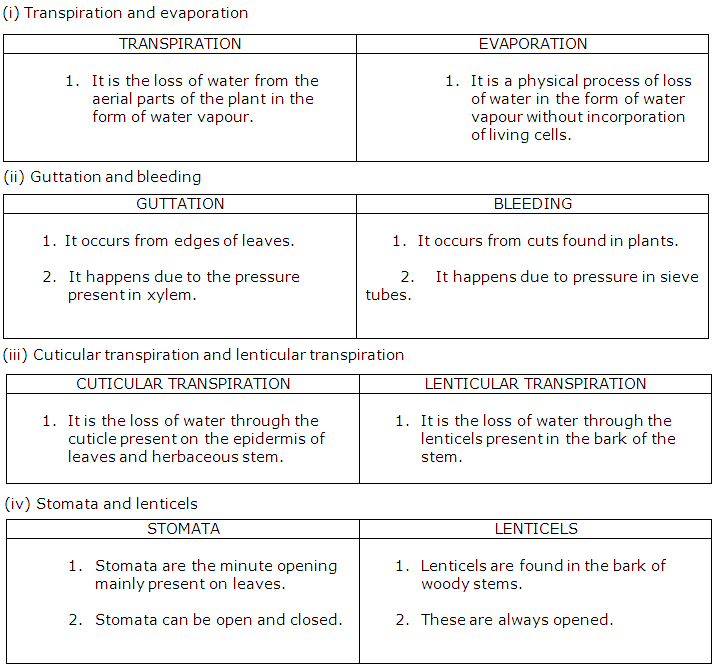
Question 13
Name the organ in which guard cells are located and mention their main functions.
Solution 13
Stomata. Their main functions include exchange of gases and transpiration.
Question 14
Name the process by which the aerial parts of a green plant give out water as water vapour.
Solution 14
Transpiration
Question 15
What is photometer? What is its use?
Solution 15
Potometer: It is an apparatus where the rate of the air bubble will indicate the rate of transpiration.It is used to measure the rate of transpiration.
Question 16
Give any three factors that enhance the rate of transpiration.
Solution 16
The three factors that enhance the rate of transpiration are:
1. High intensity of light 2. High temperature 3. Low humidity
1. High intensity of light 2. High temperature 3. Low humidity
Question 17
Explain in brief the opening and closing mechanism of stomata.
Solution 17
The opening and closing of stomata depends upon the changes in the turgidity of their guard cells. Due to absorption of water the guard cells become turgid.Their inner walls are pulled apart by their outer wall.The gap between the guard cells become wider and stomata open.When guard cells are flaccid due to loss of water, the outer walls are not stretched , their inner walls are not pulled apart decreasing the gap between the guard cells and stomata close.
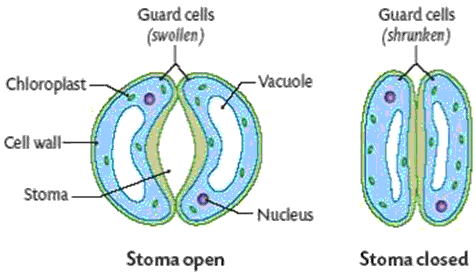

Question 18
Explain the mechanism of stomata?
Solution 18
Mechanism of stomata: Stomata are small pores present on the leaves which contains two kidney-shaped guard cells. The opening and closing of stomata depends upon the changes in the turgidity of their guard cells. Due to absorption of water the guard cells become turgid.Their inner walls are pulled apart by their outer wall.The gap between the guard cells become wider and stomata open.When guard cells are flaccid due to loss of water, the outer walls are not stretched, their inner walls are not pulled apart decreasing the gap between the guard cells and stomata close.
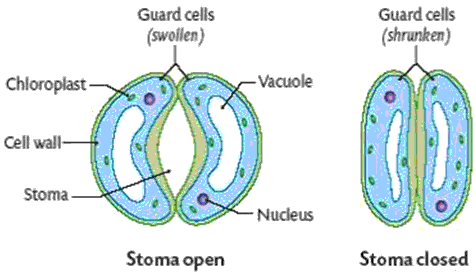

Chapter - Exercise
Solution 1
Chapter 5 - Transpiration Exercise 62
Question 1
Why do plants absorb more water than what is required by them? Give three uses of this phenomenon.
Solution 1
Plants absorb more water than what is required. Out of 100%, only 5% of the water is used in metabolic reactions while the remaining 95% is released into the atmosphere as transpiration.
The three uses of this phenomenon are:
(i) It helps in transportation of water and minerals to the various parts of the plant.
(ii) It produces a cooling effect to the plants.
(iii) It evaporates excess water.
The three uses of this phenomenon are:
(i) It helps in transportation of water and minerals to the various parts of the plant.
(ii) It produces a cooling effect to the plants.
(iii) It evaporates excess water.
Question 2
(i) Litmus paper is used to demonstrate transpiration from the leaves of the green plant. (True/ False)
(ii) Write the correct substitutes for only the first two words if it is a wrong statement.
(ii) Write the correct substitutes for only the first two words if it is a wrong statement.
Solution 2
(i) False
(ii) Cobalt chloride (CoCl2) paper
(ii) Cobalt chloride (CoCl2) paper
Question 3
Describe an experiment to prove that transpiration occurs more from the lower surface of a leaf.
Solution 3
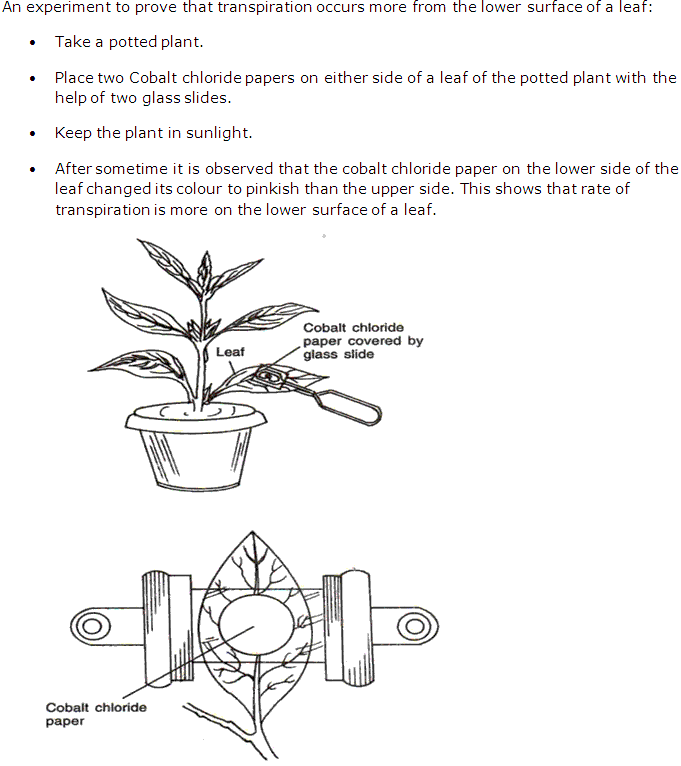
Question 4
Name the instrument used for measuring the rate of transpiration.
Solution 4
Potometer is the instrument used for measuring the rate of transpiration.
Question 5
Name the paper which is used to show loss of water through stomata of a leaf.
Solution 5
Cobalt chloride paper.
Question 6
Low humidity in the atmosphere results in decrease in the rate of transpiration. (True / false)
Solution 6
False
Question 7
Complete the following statement by choosing the correct alternative given in the brackets:
Loss of water as droplets through leaves of an intact plant is termed ______. (Bleeding/ Guttation/ Transpiration)
Loss of water as droplets through leaves of an intact plant is termed ______. (Bleeding/ Guttation/ Transpiration)
Solution 7
Loss of water as droplets through leaves of an intact plant is termed guttation.
Question 8
Mention three adaptations found in plants to reduce transpiration.
Solution 8
The three adaptations found in plants to reduce transpiration are:
1. Sunken stomata
2. Modification of leaves into spines
3. Presence of thick cuticle
1. Sunken stomata
2. Modification of leaves into spines
3. Presence of thick cuticle
Question 9
The figure below represents the set-up at the start of certain experiment to demonstrate an activity of plants:
(i) What is the aim of the experiment?
(ii) Why has oil been put in each test tube?
(iii) What will be the observations in the two test-tubes after about 2-3 days?
(iv) Give reasons to explain any change observed as answered in (iii) above.
(v) Why has the test-tube b without the plant, been taken in the experiment?
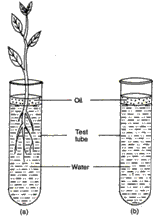
(i) What is the aim of the experiment?
(ii) Why has oil been put in each test tube?
(iii) What will be the observations in the two test-tubes after about 2-3 days?
(iv) Give reasons to explain any change observed as answered in (iii) above.
(v) Why has the test-tube b without the plant, been taken in the experiment?

Solution 9
(i) The aim of the experiment is to demonstrate transpiration.
(ii) To prevent the evaporation of water from the surface.
(iii) The level of water in test tube (a) will decrease.
(iv) The fall in the water level in the test tube (a) is because of transpiration through aerial parts of the plant.
(v) Test tube (b) has been taken as a control experiment. Since no transpiration takes place without the plant.
(ii) To prevent the evaporation of water from the surface.
(iii) The level of water in test tube (a) will decrease.
(iv) The fall in the water level in the test tube (a) is because of transpiration through aerial parts of the plant.
(v) Test tube (b) has been taken as a control experiment. Since no transpiration takes place without the plant.
Question 10
Mark the most appropriate answer in the following:
(i) If the rate of transpiration becomes more than the rate of photosynthesis, plant will
(a) Continue to live, but will not be able to store food.
(b) Be killed instantly.
(c) Grow more vigorously because more energy will be available.
(d) Stop growing and gradually die of starvation.
(ii) Transpiration pull will be maximum under which of the following conditions?
(a) Open stomata, dry atmosphere and moist soil.
(b) Open stomata, high humid atmosphere and well irrigated soil.
(c) Open stomata, high humid atmosphere and dry soil.
(d) Closed stomata, dry atmosphere and dry soil.
(i) If the rate of transpiration becomes more than the rate of photosynthesis, plant will
(a) Continue to live, but will not be able to store food.
(b) Be killed instantly.
(c) Grow more vigorously because more energy will be available.
(d) Stop growing and gradually die of starvation.
(ii) Transpiration pull will be maximum under which of the following conditions?
(a) Open stomata, dry atmosphere and moist soil.
(b) Open stomata, high humid atmosphere and well irrigated soil.
(c) Open stomata, high humid atmosphere and dry soil.
(d) Closed stomata, dry atmosphere and dry soil.
Solution 10
(i) (d) stop growing and gradually die of starvation.
(ii) (a) open stomata, dry atmosphere and moist soil.
(ii) (a) open stomata, dry atmosphere and moist soil.
Question 11
Name the opening on the stem through which transpiration occurs.
Solution 11
Cuticle, lenticels and stomata are the three openings through which transpiration occurs.
Question 12
Fill in the blanks with the function in the following:
Hydathodes: ______
Hydathodes: ______
Solution 12
Hydathodes: Guttation
Question 13
A well watered healthy potted plant with variegated leaves was kept in darkness for about 24 hours. It was then set up as shown in the diagram and exposed to light for about 12 hours. At the end of this time, leaf x and y were tested for starch. Study the diagram and answer the questions that follow:
(i) Why was the plant initially kept in darkness for 24 hours?
(ii) What is the function of sodium hydroxide solution in the flask?
(iii) Select the correct leaf from the five available choices shown in the diagram as a, b, c, d and e. Rewrite the correct answer by filling in the appropriate letter for the questions that follow:
1. After the starch test, leaf x would look like ______.
2. After the starch test, leaf y would look like ______.
(iv) The experiment with leaf y shows that photosynthesis requires the presence of certain factors. Mention any one factor.
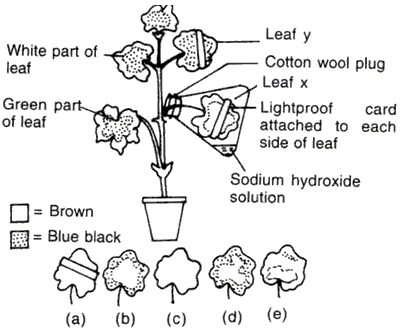
(i) Why was the plant initially kept in darkness for 24 hours?
(ii) What is the function of sodium hydroxide solution in the flask?
(iii) Select the correct leaf from the five available choices shown in the diagram as a, b, c, d and e. Rewrite the correct answer by filling in the appropriate letter for the questions that follow:
1. After the starch test, leaf x would look like ______.
2. After the starch test, leaf y would look like ______.
(iv) The experiment with leaf y shows that photosynthesis requires the presence of certain factors. Mention any one factor.

Solution 13
(i) The plant was kept in the dark to destarch the leaves.
(ii) Sodium hydroxide absorbs CO2 thereby making the flask CO2 free.
(iii) (1) C, (2) E
(iv) Sunlight
(ii) Sodium hydroxide absorbs CO2 thereby making the flask CO2 free.
(iii) (1) C, (2) E
(iv) Sunlight
Chapter 5 - Transpiration Exercise 63
Question 1
The apparatus shown here is Ganong's photometer designed to demonstrate unequal transpiration from the two surfaces of a dorsiventral leaf. Before keeping the leaf in between the cups, anhydrous calcium chloride (CaCl2) contained in two small vials were weighted and placed in both the cups. The ends of the cups were weighted and with corks through which two mercury manometers were connected. After a few hours, CaCl2 vials were taken out and weighed again.
(i) What is the purpose of keeping CaCl2 vials inside the cup?
(ii) After a few hours, CaCl2 vials were taken out and weighed again.
will you except any difference in weight? If so, give reasons.
(iii) What was expect the purpose of using a manometer?
(iv) What do you mean by transpiration?
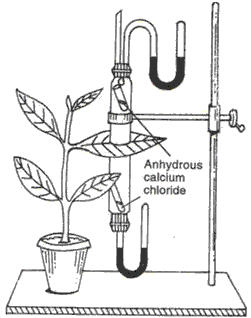
(i) What is the purpose of keeping CaCl2 vials inside the cup?
(ii) After a few hours, CaCl2 vials were taken out and weighed again.
will you except any difference in weight? If so, give reasons.
(iii) What was expect the purpose of using a manometer?
(iv) What do you mean by transpiration?

Solution 1
(i) To absorb the moisture formed by transpiration.
(ii) Yes, the weight of CaCl2 vials kept on the lower side will be more because transpiration will be more on the lower surface and the moisture absorbed.
(iii) To check the outside and inside pressure.
(iv) Transpiration is the loss of water from the aerial parts of the plant in the form of water vapour.
(ii) Yes, the weight of CaCl2 vials kept on the lower side will be more because transpiration will be more on the lower surface and the moisture absorbed.
(iii) To check the outside and inside pressure.
(iv) Transpiration is the loss of water from the aerial parts of the plant in the form of water vapour.
Question 2
The diagram alongside represents a structure found in a leaf. Study the same and answer the questions that follow:
(i) Name the parts labeled A and B.
(ii) What is the biological term for the above structure?
(iii) What is the function of the part labeled A?
(iv) Mention two structural features of A, which help in the function mentioned in (iii) above?
(v) Where is this structure likely to be found in a leaf?
(vi) The structure (fig.5.22) helps in the process of transpiration. Explain the term transpiration.
(vii) How many other cells are found surrounding this structure as seen in the diagram?
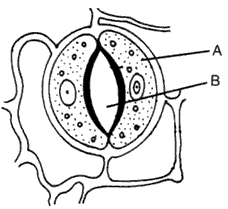
(i) Name the parts labeled A and B.
(ii) What is the biological term for the above structure?
(iii) What is the function of the part labeled A?
(iv) Mention two structural features of A, which help in the function mentioned in (iii) above?
(v) Where is this structure likely to be found in a leaf?
(vi) The structure (fig.5.22) helps in the process of transpiration. Explain the term transpiration.
(vii) How many other cells are found surrounding this structure as seen in the diagram?

Solution 2
(i) A = Guard cell
B = Stomatal aperture
(ii) Stomata
(iii) The function of the guard cells are that they help to regulate the rate of transpiration by opening and closing the stomata thus preventing excessive water loss.
(iv) The two structural features of guard cells are :
1.The guard cells have thin outer wall and thick inner wall.
2. Guard cells contain chloroplast in their cytoplasm.
(v) These are present on the lower surface of the dorsiventral leaf.
(vi) Transpiration is the loss of water in the form of water vapour from aerial parts of the plant.
(vii) Five
B = Stomatal aperture
(ii) Stomata
(iii) The function of the guard cells are that they help to regulate the rate of transpiration by opening and closing the stomata thus preventing excessive water loss.
(iv) The two structural features of guard cells are :
1.The guard cells have thin outer wall and thick inner wall.
2. Guard cells contain chloroplast in their cytoplasm.
(v) These are present on the lower surface of the dorsiventral leaf.
(vi) Transpiration is the loss of water in the form of water vapour from aerial parts of the plant.
(vii) Five
Chapter 5 - Transpiration Exercise 64
Question 1
Choose the correct answer:
(i) Which one is responsible for guttation?
(a) Diffusion (b) Root pressure (c) Transpiration (d) Photosynthesis
(ii) Rate of transpiration is more, when
(a) High humidity is present in atmosphere.
(b) Air may be stopped.
(c) Extra water is in sky.
(d) Environmental conditions may dry.
(iii) Stomata open during day time because guard cells
(a) Do photosynthesis and synthesis osmotically active.
(b) Are of thin walls.
(c) Are of bean shape.
(d) Help in exchange of gases.
(iv) The cause of wilting is more
(a) respiration (b) photosynthesis (c) absorption (d) transpiration
(v) Guttation is a mechanism of removal of water from plant by
(a) Stomata (b) hydathodes (c) lenticles (d) wounds
(vi) Secretion of sap from apex of non-injured leaf is called
(a) Evaporation (b) guttation (c) evapo-transpiration (d) transpiration
(vii) Transpiration is more
(a) From the upper surface of leaf.
(b) From the lower surface of leaf.
(c) From stem.
(d) From upper and lower surface of leaf.
(viii) The rate of transpiration is determined with the following instrument
(a) Potometer (b) Evaporimeter (c) Atmometer (d) Perimeter
(ix) In herbaceous plants, following percentage of absorbed water comes out
(a) 80 (b) 60 (c) 90 (d) 40
(x) Transpiration rate is high, when
(a) Atmospheric water is saturated with vapour.
(b) Light is very dim.
(c) Temperature is low.
(d) Atmosphere is dry and temperature is high.
(xi) More water loss in plants is the cause of wilting. This can be checked by
(a) Keeping plant in bright light
(b) Spraying alcohol on the plant
(c) Layering the bottom with Vaseline
(d) Giving more fertilizer to the soil
(xii) The percentage of cuticular transpiration in plants is
(a) Approximately 10%
(b) Approximately 20%
(c) Approximately 25%
(d) Approximately 30%
(xiii) Transpiration generates
(a) Suction force
(b) capillary force
(c) Imbibitions force
(d) atmospheric pressure
(xiv) Transpiration rate is low
(a) due to less surface area of leaf
(b) benting of leaf
(c) By sunken stomata
(d) all of these
(xv) Stomata can open in night also in
(a) xerophyte
(b) gametophyte
(c) hydrophyte
(d) none of these
(xvi) Who had said that "transpiration is a necessary evil"?
(a) Curtis (b) Steward (c) Anderson (d) J.C. Bose
(i) Which one is responsible for guttation?
(a) Diffusion (b) Root pressure (c) Transpiration (d) Photosynthesis
(ii) Rate of transpiration is more, when
(a) High humidity is present in atmosphere.
(b) Air may be stopped.
(c) Extra water is in sky.
(d) Environmental conditions may dry.
(iii) Stomata open during day time because guard cells
(a) Do photosynthesis and synthesis osmotically active.
(b) Are of thin walls.
(c) Are of bean shape.
(d) Help in exchange of gases.
(iv) The cause of wilting is more
(a) respiration (b) photosynthesis (c) absorption (d) transpiration
(v) Guttation is a mechanism of removal of water from plant by
(a) Stomata (b) hydathodes (c) lenticles (d) wounds
(vi) Secretion of sap from apex of non-injured leaf is called
(a) Evaporation (b) guttation (c) evapo-transpiration (d) transpiration
(vii) Transpiration is more
(a) From the upper surface of leaf.
(b) From the lower surface of leaf.
(c) From stem.
(d) From upper and lower surface of leaf.
(viii) The rate of transpiration is determined with the following instrument
(a) Potometer (b) Evaporimeter (c) Atmometer (d) Perimeter
(ix) In herbaceous plants, following percentage of absorbed water comes out
(a) 80 (b) 60 (c) 90 (d) 40
(x) Transpiration rate is high, when
(a) Atmospheric water is saturated with vapour.
(b) Light is very dim.
(c) Temperature is low.
(d) Atmosphere is dry and temperature is high.
(xi) More water loss in plants is the cause of wilting. This can be checked by
(a) Keeping plant in bright light
(b) Spraying alcohol on the plant
(c) Layering the bottom with Vaseline
(d) Giving more fertilizer to the soil
(xii) The percentage of cuticular transpiration in plants is
(a) Approximately 10%
(b) Approximately 20%
(c) Approximately 25%
(d) Approximately 30%
(xiii) Transpiration generates
(a) Suction force
(b) capillary force
(c) Imbibitions force
(d) atmospheric pressure
(xiv) Transpiration rate is low
(a) due to less surface area of leaf
(b) benting of leaf
(c) By sunken stomata
(d) all of these
(xv) Stomata can open in night also in
(a) xerophyte
(b) gametophyte
(c) hydrophyte
(d) none of these
(xvi) Who had said that "transpiration is a necessary evil"?
(a) Curtis (b) Steward (c) Anderson (d) J.C. Bose
Solution 1
(i) (b) Root pressure
(ii) (d) environmental conditions may dry
(iii) (a) do photosynthesis and synthesis osmotically active
(iv) (d) Transpiration
(v) (d) hydathodes
(vi) (b) guttation
(vii) (b) From the lower surface of leaf
(viii) (a) Potometer
(ix) (c) 90
(x) (d) atmosphere is dry and temperature is high
(xi) (c) layering the bottom with vaseline
(xii) (a) approximately 10%
(xiii) (a) suction force
(xiv) (d) all of the above
(xv) (a) xerophyte
(xvi) (a) Curtis
(ii) (d) environmental conditions may dry
(iii) (a) do photosynthesis and synthesis osmotically active
(iv) (d) Transpiration
(v) (d) hydathodes
(vi) (b) guttation
(vii) (b) From the lower surface of leaf
(viii) (a) Potometer
(ix) (c) 90
(x) (d) atmosphere is dry and temperature is high
(xi) (c) layering the bottom with vaseline
(xii) (a) approximately 10%
(xiii) (a) suction force
(xiv) (d) all of the above
(xv) (a) xerophyte
(xvi) (a) Curtis

0 comments:
Post a Comment